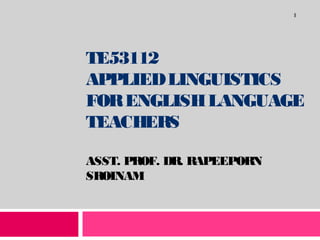
Individual Differences in SLA
- 1. 1 TE53112 APPLIED LINGUISTICS FOR ENGLISH LANGUAGE TEACHERS ASST. PROF. DR. RAPEEPORN SROINAM
- 2. Individual Differences in Second Language Learning Rod Ellis (pp.525-551) Learners vary enormously in how successful they are in learning a language. The main purpose of individual difference research was to predict which learners would succeed.
- 3. Methodology and Instrumentation Research into individual difference has relied predominantly on quantitative methods. The favored method is a survey questionnaire consisting of Likert scale that requires learners to self-report on some aspect of their language learning.
- 4. Methodology and Instrumentation The data obtained from questionnaires or tests are submitted to correlational analysis (Pearson Product Moment correlation, exploratory and confirmatory factor analysis, or multiple regression).
- 5. Methodology and Instrumentation The purpose of the correlational analysis is to identify relationship among individual difference variables and/or the relationship between a specific factor (such as motivation) and a measure of L2 achievement or proficiency. In such research, much depends on the validity and reliability of the questionnaires and tests used. Effort has gone into the development of questionnaires and well-established instruments.
- 6. Methodology and Instrumentation Some Problems There is a problem when learners are asked to agree/disagree with statements like “I ask question in English,” which they will find difficult to respond to because the behavior in question varies dynamically according to context. The statistical analysis of learners’ responses to questionnaires does not always support the theoretical constructs that underlie the designs. Different instruments for measuring the same
- 7. Instruments in researching individual different factors in SLA Modern Language Aptitude Test (MLAT) (Carroll & Sapon, 1959) for language aptitude Group Embedded Figures Test (Witkin et al., 1971) and Perceptual Learning Style Preference Questionnaire (Reid, 1987) for learning style Attitude Motivation Index (Gardner, 1985) for motivation Foreign Language Classroom Anxiety Scale (Horwitz, Horwitz & Cope, 1986) and Input
- 8. Instruments in researching individual different factors in SLA Eysenck Personality Inventory (Eysenck & Eysenck, 1964) for personality Beliefs about Language Learning Inventory (Horwitz, 1987) for learner beliefs The Strategy Inventory for Language Learning (Oxford, 1990) for learning strategies
- 9. Individual Different Factors 1. Abilities for language learning - Intelligence - Language aptitude - Memory
- 10. Individual Different Factors 2. Propensities for language learning - Learning style - Motivation - Anxiety - Personality - Willingness to communicate
- 11. Individual Different Factors 3. Learner cognitions about L2 learning - Learner beliefs 4. Learner actions - Learning strategies
- 12. Assignment 1. 2. 3. 4. Discuss the advantages and disadvantages of utilizing a survey questionnaire for correlational analysis of individual differences in second language learning. Explain differences between abilities and propensities How do learner’s abilities affect L2 learning? How do propensities affect L2 learning?
